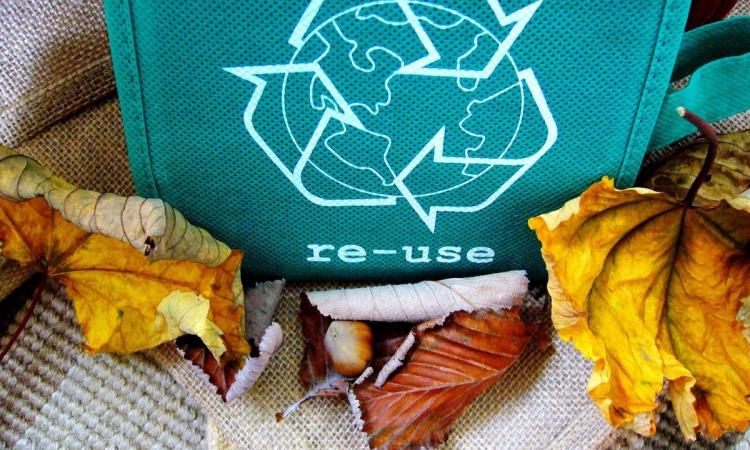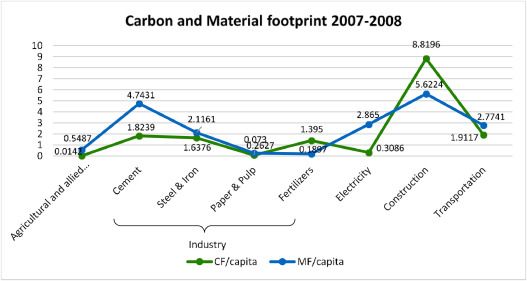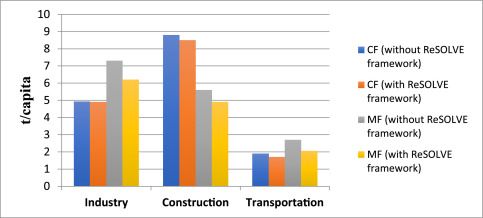
In light of the Paris Agreement 2015 and the emerging government-wide policies towards initiating a transition from linear to circular economy, it has become critical to investigate the potential impact of circular economy strategies on climate change. The recent upsurge in economic activities and growing consumerism has driven the demand for raw materials contributing to a considerable level of Greenhouse Gases (GHGs) emissions in the atmosphere, conducive to severe climate breakdowns, jeopardizing the environment and biodiversity.
As per world economic forum the circular economy outlook can save over 1 trillion dollars per year globally because of lower carbon emission, lower costs and reduction in supply chain risk and about half trillion dollars of India's GDP value can be protected by circular economy.
The structure of economy is based on the line-up process i.e., extraction-manufacturing-use-disposal, reduction, reuse, recycling, repair/refurbish and recovery of energy and materials, which transform the linear flows to circular flow, that are the keys responsible for the economic development system.
Considering the current development scenario, in the field of circular economy, India could generate annual value of Rs.14 trillion by 2030 and 40 trillion by 2050. At present, government agencies, business groups and non-profit organizations in India have recently linked their initiatives to the principles of circular economy.
Some aspects of circularity such as use and repair of vehicles, distributed recovery and reuse of post-use materials are deeply rooted in everyday habits and in fact, often handled informally, these initiatives provide the only means of livelihood for some of India's poorest classes.
Cities are home to the majority of the world's population, so urbanization plays a major role in global climate change and these cities have become major areas. This study by Bherwani et al is particularly relevant to urban areas in Delhi, and can form a baseline for other cities, where the emphasis is mainly on consumption and the economy is the service provider.
Delhi, one of India's fastest-growing cities is witnessing a rise in environmental problems as a result of numerous circumstances, including rapid growth in population and continuous increase in commercial and industrial activities, and other anthropogenic activities.
Due to stagnation and the formation of an inversion layer, Delhi has its own emission, which becomes a problem during the time. The only impact of agricultural burning that can be seen is in the city's immediate vicinity and long-distance transportation.
Environmental impacts of cities should be measured not only in terms of the productive activities that occur on their territory, but also in terms of the combination of production and consumption activities. This involves productive activities that do not occur locally but are caused by the consumption activities of cities.
Most of the production and manufacturing activities and enterprises are located outside the region but are still responsible for a quarter of global energy consumption. In order to measure the environmental impact in terms of ‘footprints’ of city, production and consumption activities of cities should be considered.
Carbon and material footprint nexus in Delhi
The main goal of this study is to see how much circular economy strategies in the city of Delhi will help mitigate climate change and what effect they have on carbon and material footprints. Circular economy strategies include maintaining materials and products in a closed-loop, reducing raw material extraction to some degree, and avoiding refining and manufacturing steps.
Study also demonstrates how and to what degree circular economy techniques may have a beneficial influence on climate change, as well as highlight and compare the benefits of improved production with the impact of modifying consumption behaviour through the deployment of circular economy strategies.
The current study aims at establishing a detailed understanding on circular economy strategies vis-à-vis Sustainable Development Goals (SDGs) and resource-energy conflict impacting climate change to underpin the priority sectors such as agriculture and allied activities, industry, construction, electricity, and transportation; exercising the circular economy Regenerate Share Optimize Loop Virtualize Exchange (ReSOLVE) framework for the National Capital Region (NCR) of India.
Agriculture, industry, construction, electricity, and transportation were the sectors selected for this study. For the current study, carbon and material footprint has been assessed for Delhi, India (2007–2008).
The method and materials used to quantify Delhi's material footprint and carbon footprint are described in this section for the year 2007–2008, as well as the circular economy policies’ potential to reduce emissions. A clear boundary definition is necessary to determine a city's environmental sustainability comprehensively. Using input-output analysis, the impact of production and consumption activities on the environment for the city were examined.
Carbon and material footprint of Delhi
The carbon footprint of Delhi for Agriculture and allied activities, Industry (Cement, Steel & Iron, Paper & Pulp, Fertilizers), Electricity, Construction and Transportation sectors are calculated as 0.0142 t/cap, 4.929 t/cap, 0.3086 t/cap, 8.8196 t/cap, 1.9117 t/cap respectively and the material footprints are 0.5487 t/cap, 7.297 t/cap, 2.865 t/cap, 5.6224 t/cap, 27,741 t/cap, and can be seen in figure below.
The total carbon footprint and material footprint for Delhi in 2007–2008 based on input output table is 15.983 t/capita and 19.121 t/capita respectively. These data points form the basis for calculation and application of circular economy framework, to work out the reduction in impacts related to climate change.

Hotspot analysis
The scatterplots are used to explore the relationship and impact between material footprint and carbon footprint. For each sector, the figure depicts the carbon footprint and material footprint in tons per capita. As it can be seen in the figure, sectors like industry, construction and transportation shares the high amount of carbon footprint and material footprint.
The industry and construction sectors have comparatively high carbon and material footprints whereas transportation sector has high material footprint and a considerable amount of carbon footprint.

The construction sector in Delhi shows significant resource consumption as indicated in the figure. It has a carbon footprint of 8.81 t CO2-eq./capita and a material footprint of 5.6 t/capita. Circular economy strategies are now applied to these identified sectors.

The circular economy strategies quantified through input-output analysis and Leontief inverse matrix, identify the construction and transportation sector as the highest contributor towards carbon footprint and material footprint ranging from 4.0–8.8 t/capita and 5.6–7.3 t/capita respectively.
Integrating the ReSOLVE strategies of circular economy and the priority sectors linked to the nation's economy through stratified components of design, consumption and recycling can reduce carbon footprint and material footprint by 0.18–15.7% and 5.3–25% respectively.
In low and middle-income countries, the study is envisaged to leverage decision-makers in adopting sustainable management practices as an integral part of policy interventions, facilitating solutions to both natural capital depletion and environmental degradation challenges to produce better Gross Domestic Product (GDP) outcomes.
The full report can be read here
/articles/can-circular-economy-strategies-mitigate-climate-change-delhi